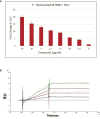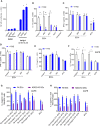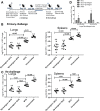NOD2/RIG-I Activating Inarigivir Adjuvant Enhances the Efficacy of BCG Vaccine Against Tuberculosis in Mice
- PMID: 33365029
- PMCID: PMC7751440
- DOI: 10.3389/fimmu.2020.592333
NOD2/RIG-I Activating Inarigivir Adjuvant Enhances the Efficacy of BCG Vaccine Against Tuberculosis in Mice
Abstract
Tuberculosis (TB) caused by Mycobacterium tuberculosis (MTB) kills about 1.5 million people each year and the widely used Bacille Calmette-Guérin (BCG) vaccine provides a partial protection against TB in children and adults. Because BCG vaccine evades lysosomal fusion in antigen presenting cells (APCs), leading to an inefficient production of peptides and antigen presentation required to activate CD4 T cells, we sought to boost its efficacy using novel agonists of RIG-I and NOD2 as adjuvants. We recently reported that the dinucleotide SB 9200 (Inarigivir) derived from our small molecule nucleic acid hybrid (SMNH)® platform, activated RIG-I and NOD2 receptors and exhibited a broad-spectrum antiviral activity against hepatitis B and C, Norovirus, RSV, influenza and parainfluenza. Inarigivir increased the ability of BCG-infected mouse APCs to secrete elevated levels of IL-12, TNF-α, and IFN-β, and Caspase-1 dependent IL-1β cytokine. Inarigivir also increased the ability of macrophages to kill MTB in a Caspase-1-, and autophagy-dependent manner. Furthermore, Inarigivir led to a Capsase-1 and NOD2- dependent increase in the ability of BCG-infected APCs to present an Ag85B-p25 epitope to CD4 T cells in vitro. Consistent with an increase in immunogenicity of adjuvant treated APCs, the Inarigivir-BCG vaccine combination induced robust protection against tuberculosis in a mouse model of MTB infection, decreasing the lung burden of MTB by 1-log10 more than that afforded by BCG vaccine alone. The Inarigivir-BCG combination was also more efficacious than a muramyl-dipeptide-BCG vaccine combination against tuberculosis in mice, generating better memory T cell responses supporting its novel adjuvant potential for the BCG vaccine.
Keywords: BCG vaccine; NOD2; RIG-I; adjuvants; antigen presentation; inarigivir; inflammasome; tuberculosis.
Copyright © 2020 Khan, Singh, Mishra, Soudani, Bakhru, Singh, Zhang, Canaday, Sheri, Padmanabhan, Challa, Iyer and Jagannath.
Conflict of interest statement
RI is a shareholder of Spring Bank Pharmaceuticals, Inc. AS, SP, and SC own stock options in SBP. The remaining authors declare that the research was conducted in the absence of any commercial or financial relationships that could be construed as a potential conflict of interest.
Figures







Similar articles
-
Future Path Toward TB Vaccine Development: Boosting BCG or Re-educating by a New Subunit Vaccine.Front Immunol. 2018 Oct 16;9:2371. doi: 10.3389/fimmu.2018.02371. eCollection 2018. Front Immunol. 2018. PMID: 30386336 Free PMC article.
-
The Profile of T Cell Responses in Bacille Calmette-Guérin-Primed Mice Boosted by a Novel Sendai Virus Vectored Anti-Tuberculosis Vaccine.Front Immunol. 2018 Aug 3;9:1796. doi: 10.3389/fimmu.2018.01796. eCollection 2018. Front Immunol. 2018. PMID: 30123219 Free PMC article.
-
A multiple T cell epitope comprising DNA vaccine boosts the protective efficacy of Bacillus Calmette-Guérin (BCG) against Mycobacterium tuberculosis.BMC Infect Dis. 2020 Sep 17;20(1):677. doi: 10.1186/s12879-020-05372-1. BMC Infect Dis. 2020. PMID: 32942991 Free PMC article.
-
Is interferon-gamma the right marker for bacille Calmette-Guérin-induced immune protection? The missing link in our understanding of tuberculosis immunology.Clin Exp Immunol. 2012 Sep;169(3):213-9. doi: 10.1111/j.1365-2249.2012.04614.x. Clin Exp Immunol. 2012. PMID: 22861360 Free PMC article. Review.
-
Mycobacterium tuberculosis proteins involved in cell wall lipid biosynthesis improve BCG vaccine efficacy in a murine TB model.Int J Infect Dis. 2017 Mar;56:274-282. doi: 10.1016/j.ijid.2017.01.024. Epub 2017 Feb 2. Int J Infect Dis. 2017. PMID: 28161464 Review.
Cited by
-
Proofreading mechanisms of the innate immune receptor RIG-I: distinguishing self and viral RNA.Biochem Soc Trans. 2024 Jun 26;52(3):1131-1148. doi: 10.1042/BST20230724. Biochem Soc Trans. 2024. PMID: 38884803 Free PMC article. Review.
-
Activation of host nucleic acid sensors by Mycobacterium: good for us or good for them?Crit Rev Microbiol. 2024 Mar;50(2):224-240. doi: 10.1080/1040841X.2023.2294904. Epub 2023 Dec 28. Crit Rev Microbiol. 2024. PMID: 38153209 Free PMC article. Review.
-
Advance in strategies to build efficient vaccines against tuberculosis.Front Vet Sci. 2022 Nov 24;9:955204. doi: 10.3389/fvets.2022.955204. eCollection 2022. Front Vet Sci. 2022. PMID: 36504851 Free PMC article. Review.
-
Immunization with CSP and a RIG-I Agonist is Effective in Inducing a Functional and Protective Humoral Response Against Plasmodium.Front Immunol. 2022 May 20;13:868305. doi: 10.3389/fimmu.2022.868305. eCollection 2022. Front Immunol. 2022. PMID: 35669785 Free PMC article.
-
A Novel Single-Stranded RNA-Based Adjuvant Improves the Immunogenicity of the SARS-CoV-2 Recombinant Protein Vaccine.Viruses. 2022 Aug 24;14(9):1854. doi: 10.3390/v14091854. Viruses. 2022. PMID: 36146661 Free PMC article.
References
Publication types
MeSH terms
Substances
Grants and funding
LinkOut - more resources
Full Text Sources
Medical
Molecular Biology Databases
Research Materials
Miscellaneous

